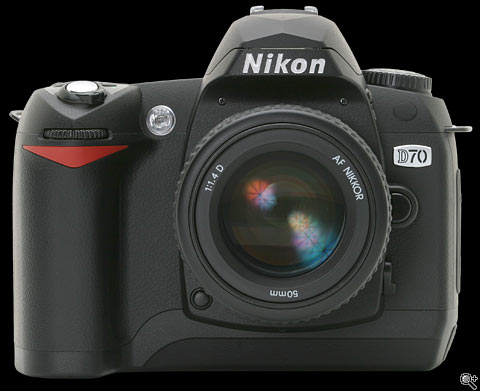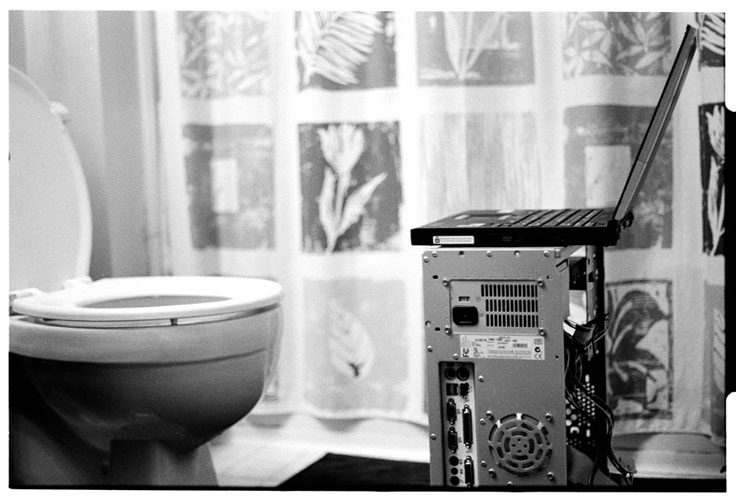Monday, April 05, 2004
San Diego Dozen
posted 12:16 AM | 0 comments
Thursday, April 01, 2004
The Existential Photographer & the Digicam

Nikon's new D70: Tempting, but ultimately wanting?
Those of you who know me well are aware that I'm a wannabe existentialist when it comes to technology in the service of art (which is really the only kind of technology that I can get that worked up about). Really, I'm trying to be realistic rather than romantic about artistic creation, specifically in the digital vs. analog debate that continues to rage on. But it's hard not to get sentimental, to get caught up in the rich traditions of creative process when, say, working with the same type of camera and filmstock that Ansel Adams used in Yosemite back in '64 or running the Panaflex that Conrad Hall employed on the set of Road to Perdition. The sheer intrinsic heft and mechanical beauty of a handmade Nikon F2 or Hasselblad 500 C/M, with the satisfying "click" they emit at the moment of truth, inspires confidence in the feeling that one is using a classic piece of art (as opposed to a mass-produced consumer commodity) to make one's own art. Whenever people pick up either of these cameras, they can't help but let out an impressed "wow" under their breath as I blush and go through the rigamarole of loading and winding Tri-X in the rear chamber and metering and focusing by hand, manually cocking the shutter between shots.
But in the end, I keep on telling myself, it's the artistic result that counts -- not my ego. Or, in the words of cinematographer David Mullen: "A difference that makes no difference is no difference." Thus, as I look at my Hassy and Nikon sitting on my shelf as I write this, I find myself considering the purchase of a digital SLR within the next few months.
If I were to pick one area that's been my primary holdout in my gradual migration to digital, it would be photography. For both still and motion picture imaging, I've continued to use and shoot film over digicams because it just looks better with its greater tonality, relatively extended exposure latitude, and a more forgiving nature under difficult lighting conditions. Ancillary considerations are that film has significantly higher resolution for large mural-size blowups (when I want to make them) and that, in many scenarios, it imposes an aesthetic appropriate to many subjects, giving images a depth and character missing in digital's slick formica.
However, for web-based publication, very few of these advantages of film are apparent, especially when viewed by folks on LCD-paneled laptops displaying a contrast ratio less than 1/10th of film. And the film workflow is kinda crazy, involving processing, proofing, and scanning (or telecine) in addition to the usual Photoshopping that images undergo before being ready for the world out there. For low-rez internet distribution, film requires a lot of work with very questionable quality gains, begging the question: if there is no difference to most viewers, it it really worth all the hassle to shoot film in the first place?
For movies, my target exhibition channel is not so much the internet as a movie theatre, so I'm not ready to give up 16mm anytime soon (calm down Mike and Marius, I agree that mini-DV makes everything look like porn). But given that many of my still images get posted on this site rather than printed poster-size on Ilford Warmtone Gloss in the darkroom, I'm seriously starting to consider a digital SLR, and Nikon's recent announcement of the D70 is perhaps my cue to act.
Judging from the previews, this camera looks like a winner. Chief among its virtues are its price, speed, and ability to use my existing arsenal of Nikon lenses, many of them dating back to the early seventies. I love Nikon glass, especially old manual focus Nikkors, and now that a sub-$1000 digital SLR looks to be available to use them, going digital is tempting.
Anyone will tell you that the cost of glass for a camera system usually far overruns the cost of the actual camera body. That's certainly been true of the several photographic systems I've owned, and it has directed me towards systems that have very long-lived and backwards-compatible standards. Or, in other words, in the land of SLR's, Nikon; in the land of medium format, Hasselblad.
There's something really nice in knowing that you can slap a 1974 manual-focus 50mm Nikkor on a state-of-the-art D70 and then turn around and mount it onto my all-manual F2as body from '78. Or that I can buy a brand new 80-200 autofocus zoom today at the store and use it on both cameras if need be. (Actually, I wouldn't necessarily have to buy an AF lens, as Nikon still manufactures and sells many of their classic manual focus lenses to this day). This effecitvely means that I can shoot digital alongside film while keeping my camera bag small and cheap. Process and equipment may be secondary to final results, but the bank account and back are always begging for mercy, notwithstanding.
Of course, there's a but to this wonderful utopian fantasy of mine. Actually, several buts.
One problem is that the D70 won't give me full functionality with these older, non-CPU manual focus lenses. To start with, the internal lightmeter won't work with them. Yup, that's right: I would have to meter with my film SLR or a standalone lightmeter unless I use the modern autofocus lenses. What else? Manual focusing is going to be a bitch with the D70 becuase its focusing screen is not designed for, err, focusing. Unlike the screens for the older Nikon cameras that include several useful focusing aids (microprisms, split-image circles) the D70 has NOTHING. Oh, and no depth of field preview with non-CPU lenses, either, because the D70 doesn't have a mechanical stop-down lever. Yes, I can use the old manual-focus Nikkors on the D70, but the question is: would I want to?
And while we're at it, let's talk about effective focal length. Because the target area of most digital camera CCD chips is substantially smaller than the 35mm frame, the effective angle of view afforded by my existing lenses in these digital systems is about 1/3 less of that I'm used to on my old film cameras. For example, my superwide 24mm lens which gives me about 75 degrees of diagonal coverage on film would register just a kinda-wide 50-degrees on all the current Nikon digi-SLRs. If I want ultrawide shots, I'm gonna have to pony up for some new digi-glass. And then get comfortable with the perspective and distortion afforded by these new focal lengths, some of them as wide as 12mm!
So what does this all mean? I don't know. Theoretically, the D70 gives me almost all of what I've been looking for in a digital SLR, but in practical terms, it may seriously trip me up by impeding the photography process I've honed over the years. I'd like to think that these hands-on process details (focusing, exposure, focal length usage) are more legitimate reasons to stay away from a digicam than the more obvious and petty spectre of interchanging silver halide for a digital CCD. But, it really just sounds like equivocation. As in all things, I'm going to have try the D70 out myself to see if I can achieve the results I want with a whole new process: using autofocus, in-camera exposure control, and ultrawide lenses in place of my old techniques. Maybe I can become the existential digital photographer, after all. Or maybe I'll find I'm just better off sticking to my current (admittedly antiquated) process. Stay tuned for the resolution of that question.
In the meantime, you can read the D70 reviews at dpreview and Ken Rockwell's website. And drool over the ability to real-time-tweak the white balance presets that come with the camera (a primary color fidelity knob for digital capture, sadly lacking in many other digital SLRs). And that true 3 fps speed with 144-frame burst cache. And instant turn-on. And the de-rigeur sleek blackness. And the 1/500th flash sync shutterspeed. Wowsuh.
posted 8:00 PM | 0 comments
